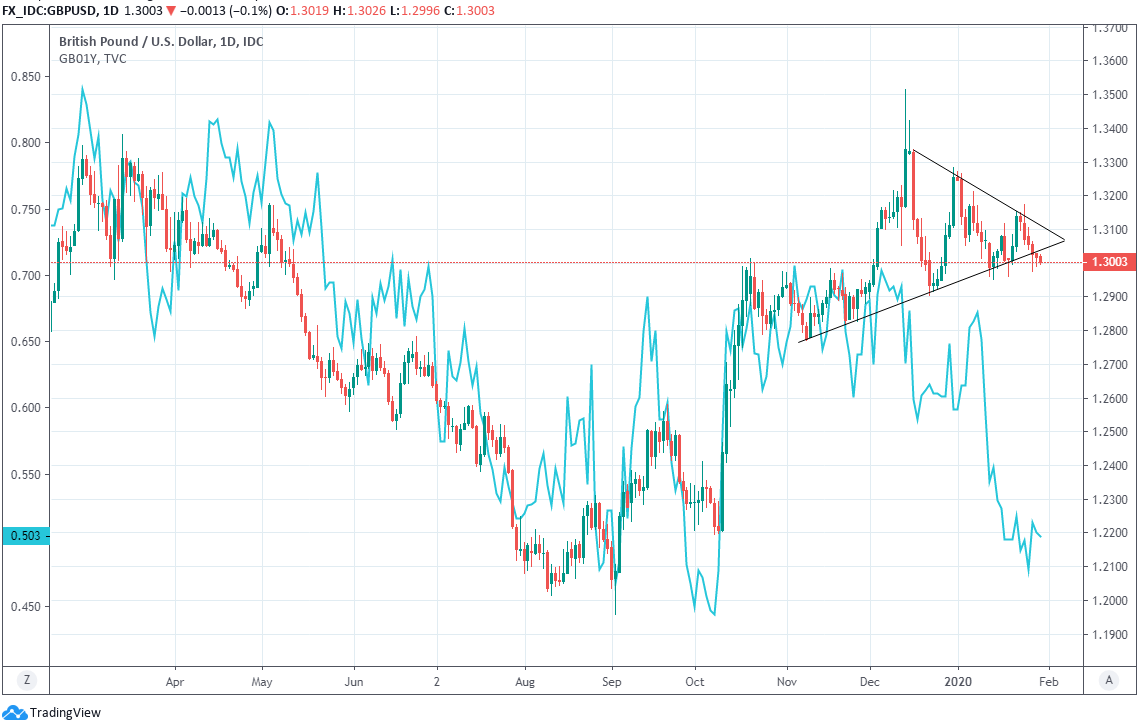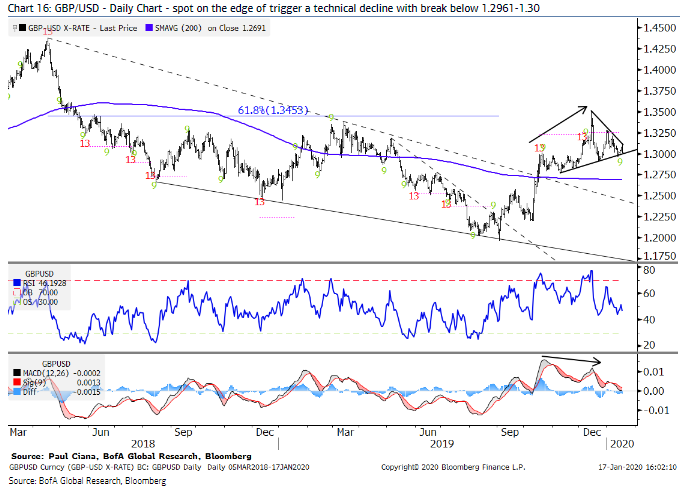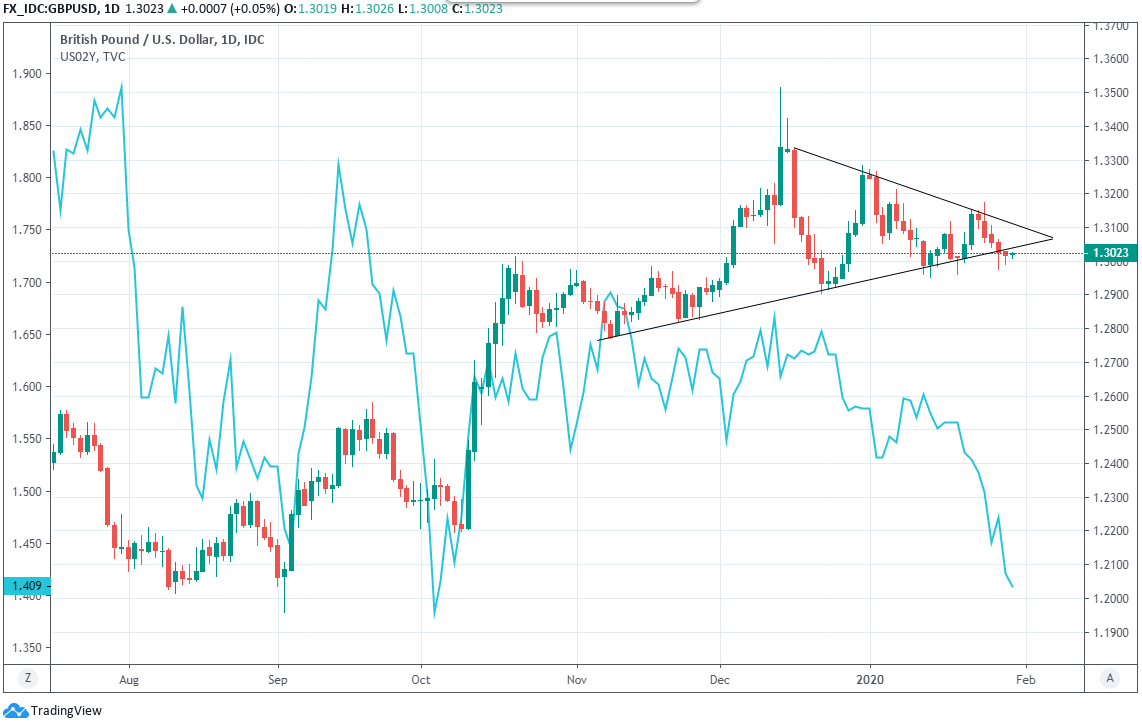Pound-Dollar Rate Uptrend Survives Fed Test but Needs BoE Boost to Endure
- Written by: James Skinner
-
- GBP clings on after Fed aids USD, but needs BoE boost.
- Support at 1.30 holds but GBP is threatening a break lower.
- Ahead of BoE decision, as market looks for rate cut to 0.50%.
- BofA Global Research looks for rate cut, fresh GBP weakness.

© lazyllama, Adobe Stock
- GBP/USD Spot rate: 1.3126, up 0.06% today
- Indicative bank rates for transfers: 1.2662-1.2753
- Transfer specialist indicative rates: 1.2853-1.2901 >> Get your quote now
The Pound was clinging to an important level of support against the Dollar early on Thursday although the upside bias in the exchange rate risks coming undone in the absence of a boost from the Bank of England (BoE), which is set to annonce the eargerly-awaited January interest rate decision at noon.
Sterling resisted the overtures of a stronger Dollar overnight in the wake of a Federal Reserve update that pointed to stability in its 1.75% cash rate for a while yet, although the upside bias that's characterised trading in the Pound-Dollar rate since mid-October is increasingly under threat.
"Daily chart prices peaked on Dec 13, 2019. Now it's at risk of a deeper Q1 decline if and only if a trend line breaks. Another close below 1.30-1.2961 confirms a technical top and signals a decline to 1.2685," says Paul Ciana CMT, chief technical analyst at BofA Global Research, in an earlier note to clients.
The Pound rose more than 10% against the Dollar between mid-October and mid-December before entering a period of consolidation on the charts, although it's now a breakout to the downside of its recent range while also testing another key technical level just as the market waits to hear if the BoE will do as many have bet and cut its interest rate from 0.75% to 0.50% at 12:00.
Multiple BoE rate setters have hinted that they could vote for a cut this month, including outgoing Governor Mark Carney, and enough of them to mean the Monetary Policy Committee may now have a majority in favour of one
Above: Pound-to-Dollar rate at daily intervals alongside 1-year GB government bond yield.
A rate cut is mostly baked into the current level of the Pound, with pricing in the overnight-index-swap market implying a 0.55% cash rate by Friday which is close to the next level down of 0.50%. That means Sterling could benefit from any BoE decision to leave interest rates unchanged but doesn't necessarily mean it wouldn't still fall if a cut does materialise because there's not telling what investors might then price-in next. Neither bond nor derivative markets reflect any expectations of an additional cut this year.
"Whether they cut or not is finely balanced, but recent BoE speeches suggest urgency. We think the story runs: spare capacity has risen because of weak growth, slowing inflation; the January PMI jump was welcome but much more is needed (); that is not guaranteed as the reality of Brexit negotiations sets in again. Whether the BoE cuts in January or decides to wait we expect them to cut twice in 2020," says Robert Wood, an economist colleague of Ciana's.
Wood's FX strategy colleagues are betting on a further decline in the Pound-to-Dollar rate over the coming weeks in response to the BoE's rate cut and uncertainty about the outcome of Brexit negotiations that are expected to hang over the economy at least through 2020.
"With market pricing for a cut finely balanced, this would suggest the risks to GBP through the MPC are asymmetric. However, in line with our tactical short bias, we think any relief rally in sterling will prove short lived as we believe markets are likely to roll out their rate cut expectations into the coming months. We continue to emphasize that the burden of proof remains on the data to drive GBP sentiment," says Kamal Sharma, in a research note.
Above: BofA Global Research graph. Pound-to-Dollar rate trend post-April 2018.
The Pound will also now have to contend with mounting unease over the coronavirus that's now spread from China to at least 17 countries and is threatening to dent global growth in at least the first quarter.
Coronavirus has spread to all 31 of China's provinces, with the National Health Commission (NHC) saying Thursday that as of 24:00 on 29 January it was aware of 7,711 confirmed cases of the super-pneumonia-like disease, up from 5,974 the previous day and from 291 on January 21. Severe cases were at 1,370, the number of suspected cases was at 12,167 and the number of individuals "undergoing medical observation" had risen to 81,947. That's according to Yandex translations of NHC statements.
Chinese cities are turning to ghost towns as the public isolate themselves in order to avoid infection and a government economist said Wednesday this could see GDP growth fall from 6% to beneath 5% this quarter, a slowdown that would be felt far beyond the borders of China. And any further spread of the virus - which is also in U.S., Australia, Canada, France, Germany... - might incite more safe-haven demand for the greenback and losses for the Pound-to-Dollar rate in the absence of a BoE rescue Thursday.
"The virus-induced panic has leaned investors toward safe-haven assets, with an apparent preference for nominal bonds as inflation expectations collapse amid concerns that the closure of retail outlets and suspension of flights will depress price growth. US Treasuries are the haven of choice, with the gold price and the Japanese yen recording marginal gains relative to the US bond market," says Nema Ramkhelewan-Bhana at Rand Merchant Bank.
Above: Pound-to-Dollar rate at daily intervals alongside 2-year U.S. government bond yield.













